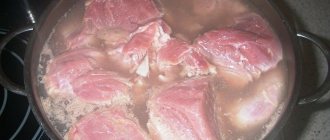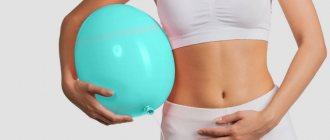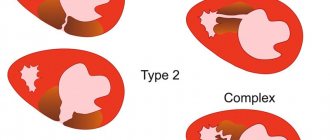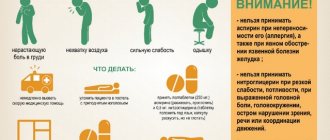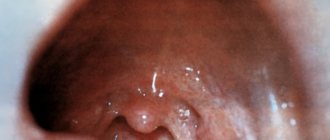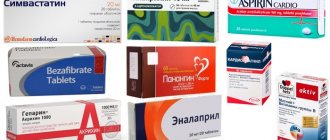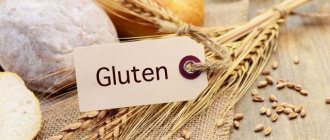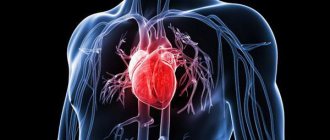Diet after myocardial infarction
There are diseases that force even those who were previously sure that they would never do this to change their diet and lifestyle. A heart attack is one of these diseases, because a person risks his life: an attack causes necrosis of such an important part of the heart muscle as the myocardium, which can lead to the most unpleasant consequences for the entire cardiovascular system. Nutrition after myocardial infarction should be thought out to the smallest detail, because your life depends on it.
Acute myocardial infarction: diet
It is important to understand that for maximum therapeutic effect, nutrition during myocardial infarction should not be corrected sometime, but immediately after the attack. At this time, as a rule, the patient is under the supervision of a doctor who can give recommendations taking into account other chronic diseases of the person.
Fractional meals are prescribed 5-7 times a day, with small portions - only 200-300 grams. Such a diet for myocardial infarction may include:
- twice a day, be sure to take half a glass of carrot juice with a spoonful of unrefined vegetable oil;
- low-fat dairy products;
- liquid, heavily boiled and mashed porridge;
- vegetable soups, broths.
During this period, you should never eat salt or foods that contain it.
Diet after a major heart attack: scarring period
As a rule, after about a month and a half, a transition to a more varied diet is prescribed in case of a large heart attack. You need to maintain a balance - 60% carbohydrates, 30% protein and 10% fat. If this condition is met, you can eat anything, even foods containing salt, but with a limit of 5-7 g of salt per day.
To maintain your health, you need to drink 3 glasses of water per day and get about the same amount from food - tea, soup, etc.
At this stage of nutrition during a heart attack, the number of meals is reduced - only 3-4 are enough, and before bed you can drink kefir or fermented baked milk.
Probably everyone who has suffered an attack will not even be surprised that proper nutrition and regimen after a heart attack will need to be followed for the rest of their lives. The following products remain prohibited forever:
- foods rich in cholesterol - egg yolks, offal, etc.;
- fatty meats, poultry, fish, lard and all sausages;
- any kind of pickles and smoked meats;
- mustard, horseradish, hot seasonings;
- strong coffee or tea;
- alcoholic drinks.
If the patient has problems with excess weight, it is recommended to reduce the consumption of flour products in order to bring the weight back to normal, since excess weight with this disease is life-threatening.
However, nutrition during a major heart attack includes a wide variety, and with skillful cooking, a person will not even feel disadvantaged or limited in food. Consider the list of desirable products:
- vegetables and greens (you should eat cabbage, including cauliflower and broccoli, 3-4 times a week);
- lean varieties of meat, fish and poultry (no more than one serving per day);
- strong meat, chicken and fish broths, including as part of soup;
- dried fruits instead of sweets - prunes, raisins, apricots, dried apricots, figs;
- milk and all types of dairy products;
- milk and sour cream sauces for dishes;
- cereals (best for breakfast are oatmeal and buckwheat);
- berries, fruits (including citrus fruits);
- pasta, black bread;
- soaked herring, seafood;
- nuts - any kind, limited, but regularly;
- legumes;
- butter and vegetable oil;
- natural compotes, jelly, jelly, jam;
- weak tea with milk or lemon, rosehip decoction;
- vegetable, berry, fruit juices - preferably freshly prepared.
An extensive heart attack requires a strict diet, because the health of the entire cardiovascular system depends on it.
Related articles:
| Nutrition for diarrhea is aimed primarily at restoring intestinal functions and replenishing water reserves in the body. The most important mistake in this disease is fasting. You need to eat, but only recommended foods. | The stroke diet is aimed at preventing the deterioration of your blood vessels and the development of the disease. From the article you will learn which foods should be permanently excluded from your diet, and which should be included in it daily. |
| Nutrition for low hemoglobin Nutrition for low hemoglobin should help raise the level of this substance in the blood. To do this, it is necessary to enrich the diet with foods high in iron, and those that will be well absorbed. Let's take a closer look. | Nutrition for oncological diseases In cases of oncological diseases, the patient’s well-being often depends on the diet. A properly selected balanced menu can help make it easier to endure treatment and recover after surgery. From the article you will find out which products are included in the permitted list. |
womanadvice.ru
Fully or partially limited products
Broths based on meat, mushrooms and fish are excluded from the diet, as well as all types of fatty meat, bacon with layers of fat, lard, any sausages, scrambled eggs with meat, pates and meat pastes, goose, duck, poultry skin, as well as all types offal - heart, liver, brains. Any fried foods, pickles, smoked foods, canned fish and meat, animal and cooking fats, coconut oil, mayonnaise and margarine are completely excluded.
The consumption of butter, fatty dairy products (sour cream, cream), unskimmed or condensed milk, and fatty cheese is limited. Consumption of chicken eggs is limited to 3 eggs per week. Fish and crustacean caviar should not be included in the diet. The intake of fried and stewed potatoes, candied fruits, fruits in syrup, hazelnuts, and almonds is limited. It is not recommended to include grape juice, potato chips, spinach, crisp potatoes, sorrel, and mushrooms in your diet. It is recommended to replace sweets with dried fruits.
From the list of products you need to cross out confectionery products, fresh white bread, sugar and products containing it, ice cream, carbonated drinks, honey. After a heart attack, the consumption of products made from butter/puff pastry, chicken egg yolks, rice, pasta, as well as caffeine-containing products (strong tea, chocolate, coffee, cocoa), which cause vasospasm and increase cardiac activity, is completely prohibited. The consumption of carbonated sweet drinks, raisins, various spices and any alcohol-containing drinks is not allowed.
Greetings! An acute heart condition such as myocardial infarction is quite serious and common. You can prevent relapse or take preventive measures with proper nutrition. Today in the article you will find a diet for a heart attack and after a heart attack, we will consider the rules of the regime, menu and other features.
Diet and nutrition during and after a heart attack
Diet during a heart attack plays a special role during the rehabilitation period. It should be lightweight so as not to create unnecessary overload for the heart, which has already suffered. Table No. 10 is what doctors call nutrition. It is suitable not only for restoring blood circulation and the functioning of the entire body after a heart attack, but also for preventing it. Indeed, in 80% of cases, cardiovascular problems can be prevented by adjusting the diet.
Why is diet necessary?
Diet after a heart attack helps achieve several important goals at once:
- help reduce the load on the cardiovascular system;
- accelerate the regeneration process;
- normalize the functioning of the gastrointestinal tract;
- improve the blood supply to the affected muscle, support metabolism.
Nutrition during a heart attack differs in that its energy value is necessarily reduced. Foods rich in fats come under special “repression”. You will have to limit salt, as well as uncontrolled fluid intake. The diet should include more foods containing vitamin C, lipotropic substances, potassium, as well as fiber to normalize motor function in the gastrointestinal tract.
Rules for building a diet
You will also have to eat differently on different days after a heart attack. So, for the first week after the appearance of a scar, one diet is typical, for the second and subsequent weeks too. During the acute period, which lasts just one week, you can eat pureed food, and in small portions. It is optimal if the number of meals is at least 6 times. In the second and third weeks of the diet after a heart attack, the nutritional rules do not change, but you can eat not only pureed food, but also simply well-chopped food.
After stenting and the end of the subacute period, a new diet is selected. At this time, scarring is actively occurring. You can eat not only chopped, but also chunky food. The remaining rules for each period of changing diets will always be the same: salt is excluded, all drinks and dishes less than 15 degrees are prohibited.
After stenting, you have to restrict yourself in your diet for a long time. Simply maintaining a diet will avoid the risk of a number of different complications. Thus, after stenting, coronary artery disease, atherosclerosis, angina pectoris, and circulatory and metabolic disorders often develop. The diet, like nutrition after a heart attack, eliminates overload of the kidneys, heart, and liver.
After stenting, the same products as described above are allowed. There is no need to neglect the consumption of fresh juices, rosehip decoctions and wheat bran.
Nutrition during a heart attack and after stenting: what is prohibited?
It is forbidden to eat food that the gastrointestinal tract cannot digest well, or that causes fermentation. It is also better not to eat sugar, baked goods and foods rich in cholesterol, so as not to overload the heart muscle. After stenting the heart vessels, you will also have to exclude:
- spices;
- fat meat;
- canned food;
- margarine;
- high-fat dairy products;
- different types of broths;
- fatty fish;
- baked goods and puff pastries;
- smoked meats
Not all foods need to be eliminated after stenting. It is quite easy to limit the consumption of some of them, only occasionally arranging days on which you can eat a small amount of them. After stenting, the following are subject to restrictions:
- raisin;
- rice;
- eggs (yolks);
- honey;
- pasta;
- semolina;
- sugar;
- grape.
Healthy foods
The diet for myocardial infarction includes a whole list of permitted foods.
- dried fruits;
- apples;
- Birch juice;
- nuts;
- lean fish;
- beet juice;
- persimmon;
- fruits and berries with vitamin C;
- garlic;
- vegetables;
- olive oil.
Among soups, for a long time you will have to limit yourself to vegetarian versions of the dish with boiled vegetables. In the first couple of days you will have to limit yourself to dried bread; later you can eat rye bread (preferably yesterday's bread). Starting from type 2 of the diet, food should be chopped and not ground to avoid stomach problems.
Food should not only be varied, but also include a number of vitamins, since nourishment is very important for the heart during the recovery period.
Diet example
The diet for a heart attack, as mentioned above, is divided into several diets, which receive considerable attention. Therefore, we will provide example menus for each of the 3 types of meals.
1 ration
Significantly reduce calorie content - up to 1100 kcal. Salt is excluded. The menu could be as follows:
- Cottage cheese, pureed to a paste, or porridge, but also pureed.
- Any grated permitted fruit is suitable as a second breakfast.
- During lunch, light soups made with vegetable broths are allowed. For the second, it is recommended to grind any vegetable to a puree state, and prepare a soufflé from lean meat.
- Berry jelly or light cottage cheese.
- For dinner, chopped buckwheat porridge with steamed fish cutlets is perfect. You can wash everything down with rosehip decoction.
- Kefir or prune tea.
2 diet
In the chemical composition of nutrition for the subacute period, up to 250 g are carbohydrates; 60 g of protein and fat are required to be eaten. You can add salt to your food, but in general you are allowed to eat no more than 3 g of salt per day. Calories - no more than 1800 for 1 day.
- Protein omelet, any porridge with added fruit (no more than 200 g).
- Curd paste.
- For lunch, any vegetarian soups are prepared. For the second, just like for menu 1, it is better to prepare mashed potatoes (not prohibited from potatoes) with chopped low-fat cutlet.
- Baked apples.
- Lemon, tea, carrot puree and light fish quenelles.
- Kefir.
Any snacks are excluded; nutrition after a heart attack should include more healthy foods.
3 diet
During the rehabilitation period, it is especially important for the heart to provide adequate nutrition, so the calorie content is increased to 2300, and the amount of salt allowed for consumption is doubled. The share of proteins in the diet is up to 90 g, carbohydrates - 320 g, and healthy fats - no more than 70 g.
Many of the restrictions that the diet included after a heart attack are lifted. So, you can consume 250 g of rye bread per day, and vegetable soups can include boiled cereal. It is still better to eat meat boiled, but you no longer need to grind it. Manna cakes, puddings and cottage cheese casseroles are allowed. As for snacks, you can already eat lean ham and pre-soaked herring. The range of berries and fruits of good ripeness and softness is significantly expanding.
Diet after a heart attack must be followed. Losing excess weight not only improves the functioning of the entire body, but also reduces the risk of a recurrent heart attack. If nutritional principles are not followed, complications such as aneurysm, pericarditis, and chronic heart failure can also occur, and this will significantly increase the likelihood of death.
iserdce.ru
What can be included in the diet
So, what can you eat after a heart attack? The diet must contain dishes with a high volume of lipotropic components, vitamins, calcium, and magnesium. Equally important is sufficient potassium intake, since it is this element that improves the functioning of the heart.
It is very important to eat foods that gently enhance intestinal motility and prevent constipation. The amount of sugar should be limited, so it can be partially replaced with honey, which is a plant biostimulant. In addition, this beekeeping product contains many vitamins and nutrients.
As the patient’s condition normalizes, the following foods can be included in the diet:
| Bread and flour products | During the period of exacerbation, you can eat crackers, in the subacute period - up to 150 g of yesterday's bread, at 3-4 weeks during scarring, the volume of yesterday's bread increases to 250 g. |
| Soups | During the acute period, vegetable soups with boiled cereals or grated vegetables are recommended - 150-200 g. Subsequently, you can eat vegetable soups, but vegetables and cereals must be well boiled - borscht, pureed carrot soup, and beetroot are allowed. |
| Meat and fish - lean varieties | It is very important to free the meat from films, fat, skin and tendons. During an exacerbation period, steamed cutlets, meatballs, dumplings, and boiled fish are allowed. Then it is allowed to include in the menu fish, poultry and meat, cooked in a whole piece. |
| Dairy | So, milk is allowed to be added to tea. You can also eat pureed cottage cheese, low-fat cheese and kefir. Sour cream can only be used for adding to soups. |
| Eggs | With this diagnosis, you can eat exclusively protein omelettes or add egg whites to soups. |
| Cereals | During an exacerbation, you can consume 100-150 g of boiled oatmeal, buckwheat or semolina kazhi. In the subacute period, you can eat liquid porridge, but it is not necessary to puree it. During scarring, you can eat 200 g of porridge, a little noodles with the addition of cottage cheese. Casseroles based on cottage cheese, buckwheat, and semolina are also allowed. |
| Vegetables | During the acute period, only pureed vegetables are allowed - pureed carrots, potatoes, beets. In the subacute period, you can eat boiled cauliflower and grated fresh carrots. Then you can eat stewed beets and carrots. In this case, the volume cannot be more than 150 g. |
| Snacks | During an exacerbation and in the subacute period, such dishes are prohibited. Then you can include herring in the menu, which should be pre-soaked, jellied fish and meat dishes, and lean ham. |
| Sweet dishes | In the first week, mousses, jellies and purees from fruits and berries are allowed. You can also eat dried fruits - dried apricots and prunes, a little honey. Then the menu should include ripe fruits and berries; jellies and milk jelly are allowed. The volume of sugar is increased to 50 g. |
| Spices and sauces | During an exacerbation and in the subacute period, it is allowed to add a little lemon or tomato juice, vinegar 3%, citric acid, milk-based sauces or vegetable broth to dishes. |
| Beverages | Fruit juices, weak tea with milk or lemon, rosehip and prune decoction, carrot or beet juice. |
Eating properly after a heart attack | Cardiovascular diseases
Proper nutrition is the prevention of recurrent myocardial infarction or acute coronary insufficiency. Compliance with certain principles allows you to strengthen the heart muscle, normalize blood pressure and reduce the frequency of angina attacks. Of course, diet alone is not enough. A patient who has suffered a myocardial infarction is doomed to take the necessary medications every day. But there are some products that greatly facilitate the work of active medicinal substances.
Back in 1987, a group of experts developed the basic principles of rational nutrition after myocardial infarction. Then, based on these recommendations, the Institute of Nutrition of the Russian Academy of Medical Sciences compiled diet number 10, which is now used everywhere in the treatment and rehabilitation of patients with pathology of the heart and blood vessels. So, let's look at what proper nutrition after a heart attack is.
Food after a heart attack
What is diet number 10
Very often, patients are recommended to follow the 10 diet after discharge from the cardiology department. This is the optimal diet for all patients with cardiovascular diseases, including those who have suffered a myocardial infarction. It is based on limited consumption of salt (up to 5 g per day) and water (no more than 1500 ml).
Products to be excluded:
- Fried, salty, spicy;
- Butter dough;
- Fatty meat, fish, poultry;
- Meat and fish semi-finished products;
- Salted and pickled vegetables;
- Legumes;
- Chocolate, strong tea and coffee.
The daily protein content is 90 g, fat - 80 g, carbohydrates - 350-400 g, calorie content - about 2600 kcal.
What foods are recommended for the 10 diet:
- Whole grain toasted bread;
- Vegetable soups;
- Lean boiled meat and poultry;
- Steamed fish cutlets;
- Low-fat dairy products;
- 2-3 eggs per week;
- Vegetable oil in small quantities;
- Boiled and fresh vegetables;
- It is better to replace sugar with dried fruits and berries;
- Rose hip decoction.
Compliance with this diet and basic nutrition is mandatory for all people with myocardial infarction, as it allows you to lead a full life, despite a serious illness.
Life after a heart attack
Traditional methods for improving the functioning of the heart and blood vessels
- Atherosclerosis is the most common cause of problems with the cardiovascular system. There are several folk recipes to combat high cholesterol.
- Garlic helps slow down the process of fat deposition in the walls of blood vessels. You can eat it raw, but if it causes palpitations, then make yourself some garlic butter. Grind a head of garlic into a pulp, pour in 1 glass of unrefined sunflower oil and after a day, pour the juice of 1 lemon into the oil infusion, then stir the mixture thoroughly. Let it brew in a cool, dark place for 7 days, shaking the contents occasionally. Take 1 teaspoon of garlic oil 3 times a day 30 minutes before meals for 3 months, then take a break for 1 month and repeat the course.
- Vegetables, fruits, berries and juices from them help get rid of cholesterol plaques. The most effective among them are citrus fruits, apples, chokeberries, and cranberries. Chew lemon zest as often as possible, which is very rich in essential oils that have a beneficial effect on blood vessels. Eat a mixture of chokeberry and honey in a ratio of 1 to 2. Take this remedy 1 tablespoon per day.
- To prevent arrhythmia, which very often complicates the course of myocardial infarction, you can eat foods high in potassium and magnesium:
- Eat 100-150 g of dried apricots, which contain a large amount of potassium, which strengthens the heart muscle.
- Walnuts contain a lot of magnesium. Crush 100 g of walnut kernels and mix them with 2 tablespoons of buckwheat honey. Eat the entire portion in 1 day in 3 divided doses.
- To support the body in the first days of myocardial infarction, freshly squeezed juices are useful, but not sweet ones:
- You can drink half a glass of carrot juice with vegetable oil 2 times a day.
- Persimmon juice and turnip juice with honey will be beneficial. For 3 months you can drink a mixture of equal parts of beet, carrot, radish and honey juices. Take 1 tablespoon 3 times a day 30 minutes before meals.
- Since patients with coronary heart disease are advised to limit sugar in their diet, you can safely replace it with honey:
- Dilute 1 tablespoon of bee honey in 1/2 cup of boiled water and sip throughout the day. Indispensable for cores and bee bread, which you can use in a mixture with honey.
- Take 1/2 teaspoon of a mixture of royal jelly and honey, prepared in a ratio of 1:100, 3 times a day. Keep the mixture in your mouth until completely dissolved. The course of treatment with royal jelly should be at least 2-4 weeks.
Nutrition during a heart attack
The main thing to remember is that a heart attack is not a death sentence and life goes on after it. And the correct daily routine, moderate physical activity approved by the doctor, and strict adherence to nutrition after a heart attack will help with this. Of course, you will have to take pills every day, but to help the medications strengthen your heart muscle, you need to eat right. The most important thing is not to overeat, limit salt and water intake, exclude fried, spicy and fatty foods, strong coffee and tea, eat more vegetables, fruits and fish. And then the joy of life will continue for many more years.
heartbum.ru
Rehabilitation
Diet after myocardial infarction for men should exclude any pork dishes. You need to avoid shrimp and squid, red or black caviar, salty cheeses and sausages.
The duration of rehabilitation depends on the severity of the infarction, the extent of myocardial damage, the patient’s age, and concomitant somatic diseases. So, with a small amount of necrosis, the recovery period takes about six months. An extensive process can double this period. Risk factors that cause circulatory disorders and provoke an attack at the same time aggravate, complicate and prolong the duration of treatment. These include:
- hypertension leading to stroke;
- diabetes;
- cerebral circulatory disorders (ischemic stroke);
- elderly age.
If doctors managed to stop the destructive effects of a heart attack under intensive care conditions, then the patient must follow all recommendations regarding nutrition. After discharge from the hospital, the diet remains according to the diet. This is an important stage after heart attack rehabilitation, which can save and prolong life.
“>
Nutrition for extensive myocardial infarction
March 21, 2020
Proper nutrition during the rehabilitation period after a major myocardial infarction can improve heart function and speed up recovery processes in the myocardium.
In the first ten days after a heart attack, you need to follow a strict diet, which includes only low-calorie foods. It is necessary to limit salt and liquid intake. It is recommended to consume liquid porridges, fruit and vegetable purees and pureed soups. For meat dishes, you can have boiled lean beef.
In the second half of the rehabilitation period (after two weeks), the same thing is taken, but it can be boiled rather than pureed. Salt intake is limited.
After a month, during the period of scarring, foods enriched with potassium are needed. It increases the outflow of fluid from the body and increases the ability of the muscle to contract. It is useful to eat dried fruits, dates, bananas, cauliflower.
You should eat apples as much as possible; they help cleanse the entire body of toxins and strengthen the walls of blood vessels.
It is recommended to replace sugar with honey, as it is a natural biostimulant. Honey enriches the body with essential microelements and vitamins, dilates heart vessels, improves blood supply to the body and increases its protective reactions.
It is useful to eat nuts, especially walnuts and almonds. Walnuts contain magnesium, which has vasodilating properties, as well as potassium, copper, cobalt, zinc, necessary for the formation of red blood cells.
Birch sap is very useful; you can drink from 0.5 liters to 1 liter per day.
It is useful to eat turnips, persimmons, and drink beet juice.
People who have suffered a myocardial infarction need to introduce seafood into their regular diet, as they contain iodine, cobalt and copper. These trace elements thin the blood and prevent the formation of blood clots.
Dangerous and harmful products for myocardial infarction
Patients who have had a myocardial infarction due to obesity need to completely reconsider their diet and subsequently, by contacting specialists, create a diet aimed at gradually reducing body weight.
People who have suffered a heart attack for some other reason must completely eliminate fatty, fried, and flour products from their diet until complete rehabilitation. It is forbidden to consume foods that lead to bloating: legumes, milk, flour products. The consumption of fatty and fried foods is completely contraindicated throughout the entire post-infarction period.
Excluded from the diet: smoked foods, marinades, mushrooms, salted cheeses. Dishes cooked in meat or fish broth are contraindicated.
When enriching your body with potassium, be careful with gooseberries, radishes, sorrel, and black currants, since in addition to potassium, they also contain oxalic acid, which is prohibited for heart diseases.
Diet No. 10a
Prescribed for diseases of the cardiovascular system complicated by stage II–III circulatory failure, as well as in acute and subacute periods of myocardial infarction and stage III hypertension. The diet allows you to restore impaired blood circulation, normalize kidney function and improve water and electrolyte metabolism.
This diet involves limited consumption of bread (only crackers are allowed), exclusion of first courses from the diet, and reduction in the amount of fats, proteins and carbohydrates. You should prepare dishes without salt and eat salt-free bread.
All food should be pureed or boiled to increase its digestibility and protect the cardiovascular system. You can give dishes a sour or sweet taste and flavor them.
Fried, cold and hot foods, coffee, strong tea, grape juice, mineral waters high in sodium and other foods that excite the central nervous and cardiovascular systems, irritate the liver and kidneys, and burden the gastrointestinal tract are also excluded from the diet. promote flatulence.
The total calorie content of food is 1900–2000 kcal. The daily intake of liquid is 600–800 ml, protein – 60 g (70% animal), fat – 50 g (20–25% vegetable), carbohydrates – 300 g (70–80 g sugar and other sweets). The diet is split, consisting of 6–7 meals per day. You should eat food in small portions.
For diet No. 10a, the following dishes and products are recommended:
– weak tea with lemon or milk, coffee drinks, rose hip decoction; – 1 egg per day (soft-boiled, steam omelet, in dishes); – whole milk (if it does not cause flatulence), fresh grated cottage cheese and dishes made from it; fermented milk products (kefir, acidophilus, yogurt), sour cream can only be added to dishes; – porridge with water with milk, semolina soufflé, as well as pureed rice, rolled oats and buckwheat; – boiled vermicelli; – salt-free wheat bread 1st and 2nd grade, dried, croutons made from it, unsweetened cookies (no more than 150 g/day); – 200 g of milk soup or vegetable broth with the addition of pureed cereals and vegetables (consume warm); – low-fat varieties of beef and veal , rabbit, chicken and turkey meat, boiled and pureed or chopped; – low-fat fish, boiled in pieces or chopped; – carrots, beets, cauliflower, pumpkin and zucchini, boiled and pureed (mashed potatoes, soufflé, baked meatballs, etc. .). Potatoes (only mashed or boiled) and ripe raw tomatoes should be consumed in limited quantities. Add dill and parsley to dishes; ripe soft fruits and berries in raw form, dried fruits (soaked), compotes from them. Baked or pureed fresh apples are very useful. From fruits you can prepare compotes, jelly, mousses, jelly, sambuca; - honey, jam, sugar, marmalade and marshmallows; - sauces and gravies prepared with water, vegetable broth, milk, with the addition of tomato and fruit juices, citric acid, sweet and sour fruits and vegetables, as well as white sauce. Among the spices and seasonings you can use vanillin, cinnamon and bay leaf;
– fresh butter and refined vegetable oils (if tolerated) can be added to dishes (5–10 g/day).
Menu for diet No. 10a
1st breakfast: oatmeal porridge (semolina or pureed buckwheat), pureed milk and milk (100 g).
2nd breakfast: baked apples with sugar or honey.
Lunch: steamed meatballs, mashed potatoes with stewed cabbage, dried fruit compote.
Afternoon snack: soaked prunes with a small amount of vegetable oil.
1st dinner: baked beetroot and apple meatballs, tea with milk (100 g).
2nd dinner: rose hip or yogurt decoction (100 g).
Diet No. 10i
Prescribed for myocardial infarction. With the help of a diet, you can speed up reparative processes in the myocardium, improve blood circulation, normalize intestinal motor function and thereby ensure a heart-sparing regime.
Foods that stimulate the nervous and cardiovascular systems and cause flatulence are excluded from the diet. Table salt is also excluded. The amount of liquid, including liquid meals, is limited to 750 ml/day. The total calorie content of the diet is 1000 kcal. All products should be consumed pureed and chopped, boiled or baked after boiling. Fruit juices, decoctions, soufflés, purees, pureed cottage cheese, lactic acid products, etc. are recommended. Small meals are taken - 7-8 times a day. You need to eat food in small portions.
In most cases, the diet lasts 7–10 days, then it can be gradually expanded by including physiologically complete foods in the diet. 3 weeks after switching to a more nutritious diet, the calorie content of the diet can reach 1600 kcal, and the amount of liquid consumed per day can be 1 liter. Then the patient is transferred to diet No. 10c.
Diet No. 10c
The diet is used for atherosclerosis of coronary, cerebral and peripheral vessels, atherosclerosis of the aorta, atherosclerotic cardiosclerosis. Diet therapy allows you to slow down the development of the atherosclerotic process, restore impaired fat metabolism, and generally normalize general metabolism.
The following products are excluded from the diet: refractory fats, pickles, smoked meats, strong meat, fish, chicken and mushroom broths, salted fish, canned food, radishes, radishes, legumes, sorrel, spinach, mushrooms, grape juice, as well as pastry products. The consumption of sweets (including sugar) should be limited to 30 g/day.
The protein content remains within the physiological norm, the amount of fat (mainly animal) and carbohydrates (mainly simple) should be reduced. The daily intake of table salt is 3–5 g. The diet should be enriched with polyunsaturated fatty acids (from vegetable fat), dietary fiber and lipotropic substances such as methionine, choline and lecithin. The total calorie content of the diet is 2400–2500 kcal. If you are obese, caloric intake should be reduced to 2000 kcal. This can be done by limiting your carbohydrate intake.
The following dishes and products are recommended for diet No. 10c:
– weak tea and coffee drinks (with milk, sugar, lemon), rosehip decoction, fruit juices diluted with water; – 1 egg per day in the form of a protein steamed omelet; – whole boiled milk, fermented milk drinks, low-fat cottage cheese and dishes made from it; sour cream can only be used for dressing; – crumbly and viscous porridges cooked in water or milk, as well as puddings, cereals and pasta casseroles; – grain, bran, peeled, rye and wheat bread made from 2nd grade flour; – vegetarian vegetable dairy and fruit soups (with cereals and pasta), cabbage soup, beetroot soup; – lean varieties of beef and pork, chicken and turkey meat, boiled or baked after boiling, in pieces or chopped; – lean varieties of fish, boiled or baked (after boiling) form; – any vegetables raw, boiled or baked; – ripe and sweet fruits and berries in their natural form, dishes prepared from them (jelly, mousses, compotes);
– vegetable and animal fats in equal quantities.
This article uses materials from open sources: edaplus.info, infocardio.ru
Source: health info
healthinfo.ua
Authorized Products
To minimize the risk of complications, it is necessary to include foods rich in polyunsaturated fatty acids, fiber and complex carbohydrates in your diet. The menu includes soups made with vegetable broth with the addition of well-cooked cereals and potatoes (beetroot soup, cabbage soup, borscht). For second courses, low-fat varieties of white fish (hake, cod, tuna, flounder) and seafood (shrimp, mussels, squid, seaweed), as well as lean varieties of red meat and dietary poultry (turkey, chicken), boiled rabbit or baked, chopped or in pieces. Refined vegetable oils (sunflower, olive), as well as fatty fish: sardines, herring, tuna, salmon (salmon, chum salmon, pink salmon) are recommended as fats.
The diet includes low-fat, unsalted cheeses and low-fat dairy products (kefir, fermented baked milk). Bakery products in the diet are present in the form of whole grain products, wholemeal flour, yeast-free bread, and oatmeal cookies. The volume of fruits and vegetables consumed in any form and method of culinary processing is increasing, as well as freshly squeezed juices from berries (blackberries, strawberries, blueberries) and fruits, walnuts.
Eating fresh herbs and cereal dishes is extremely beneficial. To improve blood circulation, it is necessary to include decoctions of rosehip and wheat bran in the diet. Lipid metabolism indicators are favorably affected by drinking mineral waters, mainly sodium bicarbonate, chloride, sulfate or water of mixed cationic composition (Borjomi, Essentuki No. 4, No. 17, Luzhanskaya, Smirnovskaya).
Table of permitted products
Vegetables and greens
| Proteins, g | Fats, g | Carbohydrates, g | Calories, kcal | |
| eggplant | 1,2 | 0,1 | 4,5 | 24 |
| beans | 6,0 | 0,1 | 8,5 | 57 |
| zucchini | 0,6 | 0,3 | 4,6 | 24 |
| cabbage | 1,8 | 0,1 | 4,7 | 27 |
| broccoli | 3,0 | 0,4 | 5,2 | 28 |
| Brussels sprouts | 4,8 | 0,0 | 8,0 | 43 |
| green onion | 1,3 | 0,0 | 4,6 | 19 |
| bulb onions | 1,4 | 0,0 | 10,4 | 41 |
| cucumbers | 0,8 | 0,1 | 2,8 | 15 |
| squash | 0,6 | 0,1 | 4,3 | 19 |
| salad pepper | 1,3 | 0,0 | 5,3 | 27 |
| parsley | 3,7 | 0,4 | 7,6 | 47 |
| beet | 1,5 | 0,1 | 8,8 | 40 |
| celery | 0,9 | 0,1 | 2,1 | 12 |
| soybeans | 34,9 | 17,3 | 17,3 | 381 |
| asparagus | 1,9 | 0,1 | 3,1 | 20 |
| tomatoes | 0,6 | 0,2 | 4,2 | 20 |
| Jerusalem artichoke | 2,1 | 0,1 | 12,8 | 61 |
| pumpkin | 1,3 | 0,3 | 7,7 | 28 |
| dill | 2,5 | 0,5 | 6,3 | 38 |
| beans | 7,8 | 0,5 | 21,5 | 123 |
| garlic | 6,5 | 0,5 | 29,9 | 143 |
| lentils | 24,0 | 1,5 | 42,7 | 284 |
Fruits | ||||
| avocado | 2,0 | 20,0 | 7,4 | 208 |
| oranges | 0,9 | 0,2 | 8,1 | 36 |
| grapefruit | 0,7 | 0,2 | 6,5 | 29 |
| pears | 0,4 | 0,3 | 10,9 | 42 |
| lemons | 0,9 | 0,1 | 3,0 | 16 |
| mango | 0,5 | 0,3 | 11,5 | 67 |
| tangerines | 0,8 | 0,2 | 7,5 | 33 |
| nectarine | 0,9 | 0,2 | 11,8 | 48 |
| peaches | 0,9 | 0,1 | 11,3 | 46 |
| apples | 0,4 | 0,4 | 9,8 | 47 |
Berries | ||||
| gooseberry | 0,7 | 0,2 | 12,0 | 43 |
| Red currants | 0,6 | 0,2 | 7,7 | 43 |
| black currant | 1,0 | 0,4 | 7,3 | 44 |
Nuts and dried fruits | ||||
| nuts | 15,0 | 40,0 | 20,0 | 500 |
| flax seeds | 18,3 | 42,2 | 28,9 | 534 |
| fenugreek seeds | 23,0 | 6,4 | 58,3 | 323 |
| sunflower seeds | 20,7 | 52,9 | 3,4 | 578 |
Cereals and porridges | ||||
| buckwheat (kernel) | 12,6 | 3,3 | 62,1 | 313 |
| oat groats | 12,3 | 6,1 | 59,5 | 342 |
| cereals | 11,9 | 7,2 | 69,3 | 366 |
| wheat bran | 15,1 | 3,8 | 53,6 | 296 |
Dairy | ||||
| kefir 0% | 3,0 | 0,1 | 3,8 | 30 |
| kefir 1% | 2,8 | 1,0 | 4,0 | 40 |
Cheeses and cottage cheese | ||||
| cottage cheese 0.6% (low fat) | 18,0 | 0,6 | 1,8 | 88 |
| curd tofu | 8,1 | 4,2 | 0,6 | 73 |
Meat products | ||||
| beef | 18,9 | 19,4 | 0,0 | 187 |
Bird | ||||
| chicken fillet | 23,1 | 1,2 | 0,0 | 110 |
| turkey | 19,2 | 0,7 | 0,0 | 84 |
| eggs | 12,7 | 10,9 | 0,7 | 157 |
Fish and seafood | ||||
| fish | 18,5 | 4,9 | 0,0 | 136 |
| seaweed | 0,8 | 5,1 | 0,0 | 49 |
Oils and fats | ||||
| grape seed oil | 0,0 | 99,9 | 0,0 | 899 |
| linseed oil | 0,0 | 99,8 | 0,0 | 898 |
| olive oil | 0,0 | 99,8 | 0,0 | 898 |
| sunflower oil | 0,0 | 99,9 | 0,0 | 899 |
Non-alcoholic drinks | ||||
| mineral water | 0,0 | 0,0 | 0,0 | – |
| instant chicory | 0,1 | 0,0 | 2,8 | 11 |
| green tea | 0,0 | 0,0 | 0,0 | – |
Juices and compotes | ||||
| cranberry jelly | 0,0 | 0,0 | 13,0 | 53 |
| rose hip juice | 0,1 | 0,0 | 17,6 | 70 |
* data is per 100 g of product
Main rules
After an attack, you must follow a number of very important rules.
- Food should be taken six or seven times a day.
- Portion sizes should not be large.
- You should eat food that is not very cold and not very hot.
- Since salt retains fluid in the body, which leads to edema, complicating the work of the heart, it is important to exclude it from the diet, especially at first.
- It is important to eat foods that contain magnesium and potassium, as these elements have a beneficial effect on the functioning of the heart. Such products can be: prunes, nuts, buckwheat, cabbage, seaweed, beets, potatoes, watermelons and citrus fruits.
- Sugar negatively affects blood clotting, so you need to limit its consumption.
- The calorie intake should be reduced because less energy is expended during bed rest, and too many calories can contribute to insomnia.
- Liquids should be consumed no more than one and a half liters. To quench your thirst, it is useful to use weak fruit or black tea.
- Foods that cause bloating and gas are harmful, such as bread, grape juice, carbonated drinks, and so on. Light foods that do not cause indigestion are healthy.
- The consumption of animal fats should be minimal. This will help improve lipid metabolism, the disruption of which can lead to atherosclerosis.
Why diet number 10?
The diet after myocardial infarction is shown at number 10. Thanks to its action, processes in the heart muscle are restored, intestinal motor activity is normalized, metabolism and blood circulation are improved, and the load on the heart and blood vessels is reduced. It complies with the above rules, therefore it has a beneficial effect on human health, undermined by a heart attack.
This diet includes three diets, which depend on the period after a heart attack and are prescribed by a doctor.
- The first diet is usually used in the first week after an attack, that is, during the most acute period. The dishes are pureed and are taken six times a day.
- The second diet is prescribed in the subacute period, that is, in the second and third weeks. Food is also consumed six times a day, and it is crushed.
- The third diet is applied at the scarring stage, in the fourth week. The food is taken five times, chopped and in pieces.
Next, we will consider all three diets in turn, studying the consumption of the following products: bread, soups, fish, poultry, meat, eggs, cereals, dairy products, vegetables, spices, sauces, snacks, sweets, fruits, fats, drinks.
Sample menu
Nutritionists and doctors have long established a connection between diseases and the lack of pleasure from the food consumed. Therefore, it is important to ensure that the food is not only healthy, but also tasty. Today, due to the prevalence of this cardiac anomaly, there are a large number of dietary recipes for a patient with myocardial infarction.
Zucchini + meat puree
One of the recommended dietary recipes for a patient with myocardial infarction is this one. In order to prepare this simple, delicate, but tasty and satisfying dish, you need to do the following manipulations:
- boil beef (150 grams) or chicken fillet, then chop the meat;
- simmer the main ingredient in boiled water;
- Peel the zucchini (two pieces), cut into bars and place in a saucepan;
- wipe and simmer the finished product;
- Mix the egg yolk with milk and pour the mixture into the puree, then add salt.
Mix all ingredients, add a little butter, remove from heat.
lechenie-sosudov.ru
If you have undergone stenting
Diet after a myocardial infarction is just as important as after an operation such as stenting, which supports the walls of a vessel that is narrowed by the pathological process. At the same time, the diet helps prevent the development of atherosclerosis. In order to choose the right diet, you should also consult a doctor. However, you also need to limit your intake of fats and salt, and eat more fruits and vegetables. If there is a large amount of cholesterol in the blood due to food, there will be little effect from physical therapy, so you need to eat less butter, sour cream, lard and fatty meat.
It doesn’t matter who got sick and had a heart attack or surgery, a man or a woman, because each organism experienced enormous strain and stress, which threatened the patient’s life. To correct this situation, every effort must be made, for example, to carefully follow a diet. Only a qualified doctor will help in creating a menu and selecting other preventive measures. His advice can not only improve your health, but also save your life.
cardio-life.ru

